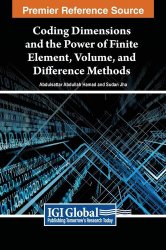Coding Dimensions and the Power of Finite Element, Volume, and Difference Methods
- Добавил: literator
- Дата: 23-09-2024, 03:31
- Комментариев: 0
 Название: Coding Dimensions and the Power of Finite Element, Volume, and Difference Methods
Название: Coding Dimensions and the Power of Finite Element, Volume, and Difference MethodsАвтор: Abdulsattar Abdullah Hamad, Sudan Jha
Издательство: IGI Global
Год: 2024
Страниц: 301
Язык: английский
Формат: pdf (true), epub
Размер: 18.8 MB
Engineers, researchers, and students attempting to effectively utilize numerical methods to solve complex engineering problems in today's fast-paced technological world are increasingly struggling to keep up without the necessary tools. While theoretical knowledge is vital, it can feel disconnected from practical application, leaving many ill-equipped to tackle real-world challenges. Coding Dimensions and the Power of Finite Element, Volume, and Difference Methods offers a comprehensive understanding and hands-on experience with numerical methods, empowering you to push the boundaries of innovation. By providing practical examples of coding and real-world applications, you will be equipped with the skills to tackle dynamic systems, partial and ordinary differential equations, and other mathematical simulations confidently.
This volume aims to empower engineers, researchers, and students to push the boundaries of innovation by offering a solid foundation in numerical methods and their practical implementations. With a particular emphasis on hands-on coding examples, “Coding Dimensions” serves as a comprehensive guide to tackling engineering challenges using finite element, volume, and difference methods. By delving into the potential of these techniques, readers are invited to unlock their power through coding and embark on a journey of computational exploration.
The target audience of this book includes professionals and researchers working in the fields of education, scientific research, computer science, and information technology. Moreover, this book provides invaluable insights and support for executives and researchers seeking to combine mathematics with other sciences, thereby keeping pace with technological advancements. By doing so, it empowers engineers, researchers, and students to innovate and excel in their respective fields through a thorough understanding of numerical methods and their applications.
Covering a wide array of topics, this book starts with the fundamentals of numerical methods, introducing their applications in engineering and offering an overview of finite element, volume, and difference methods. It delves into the mathematical foundations and principles behind these methods, essential for numerical analysis and error estimation. The book also addresses the generation of structured and unstructured meshes, techniques for mesh refinement, and methods for handling irregular and complex geometries, ensuring accuracy and efficiency in computations.
Readers will find comprehensive discussions on solving linear and nonlinear problems, with chapters dedicated to linear algebraic systems, direct and iterative matrix-solving methods, preconditioning, and parallel computation techniques. The treatment of nonlinear problems includes solutions for nonlinear equations, Newton-Raphson methods, and applications in structural, thermal, and fluid analysis. For time-dependent problems, the book explores time integration schemes, stability and accuracy analysis, and solutions for heat conduction, wave propagation, and diffusion problems using fully implicit and explicit schemes.
The book further delves into parallel computing techniques, covering distributed memory architectures, domain decomposition, message-passing interfaces, and GPU utilization for numerical computations. Advanced topics include higher-order basis functions, adaptive mesh refinement, design optimization, multiphysics simulations, and coupling methodologies. Additionally, the book provides insights into software development and best practices, introducing programming languages used in numerical methods, software engineering principles, verification and validation of numerical models, and relevant software libraries and open-source projects.
Contents:
Скачать Coding Dimensions and the Power of Finite Element, Volume, and Difference Methods
Внимание
Уважаемый посетитель, Вы зашли на сайт как незарегистрированный пользователь.
Мы рекомендуем Вам зарегистрироваться либо войти на сайт под своим именем.
Уважаемый посетитель, Вы зашли на сайт как незарегистрированный пользователь.
Мы рекомендуем Вам зарегистрироваться либо войти на сайт под своим именем.
Информация
Посетители, находящиеся в группе Гости, не могут оставлять комментарии к данной публикации.
Посетители, находящиеся в группе Гости, не могут оставлять комментарии к данной публикации.

